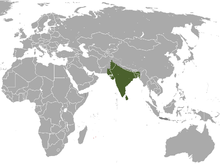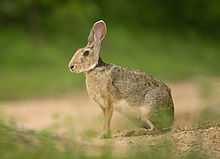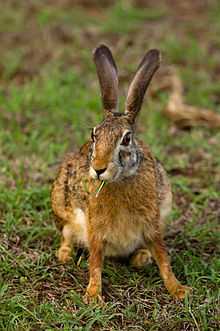Indian hare
| Indian hare[1] | |
|---|---|
 | |
| Conservation status | |
| Scientific classification | |
| Kingdom: | Animalia |
| Phylum: | Chordata |
| Class: | Mammalia |
| Order: | Lagomorpha |
| Family: | Leporidae |
| Genus: | Lepus |
| Species: | L. nigricollis |
| Binomial name | |
| Lepus nigricollis F. Cuvier, 1823 | |
 | |
| Indian Hare range (green - native, red - introduced, dark grey - origin uncertain) | |
The Indian hare (Lepus nigricollis), also known as the Black-naped Hare, is a common species of hare found in the Indian Subcontinent.[3] and in Java. Introduced to Madagascar, Comoro Islands, Andaman Islands, Irian Jaya, Papua New Guinea, Seychelles, Mayotte, Mauritius and Réunion[4]
Taxonomy
There are 7 recognized subspecies of Indian hare.
- Lepus nigricollis aryabertensis
- Lepus nigricollis dayanus
- Lepus nigricollis nigricollis
- Lepus nigricollis ruficaudatus
- Lepus nigricollis sadiya
- Lepus nigricollis simcoxi
- Lepus nigricollis singhala
Description
Lepus nigricollis are also called black-naped hares due to the patch of black fur that runs along the nape of the neck. The top of the tail is also black and the back and face are brown with black hairs scattered throughout. The underparts are white. Total length ranges from 40 to 70 cm and weight ranges from 1.35 to 7 kg.

Like all hares, they have long ears and large hind feet which are well furred. There is some evidence that hares that have been introduced to islands are smaller than those in mainland India. Regardless of location, female L. nigricollis tend to be larger than males.

Behaviour
Usually they spend much of the daytime sleeping in "forms" or depressions made in the grass. Occasionally they will be seen stretched out on their sides, sunning themselves. They are primarily diurnal and solitary, though may aggregate somewhat for breeding.
Reproduction
During mating season, male become aggressive, sparring with other males using their forepaws and "boxing" with their hind feet. Males will attempt to mate with as many females as they can. Reproduction rates tend to be at their highest during the wet season, though L. nigricollis will generally breed year round. The increased rate of reproduction is likely the result of an increase in nutrient rich foods. On average, 69% of adult females are pregnant every year. In L. nigricollis dayanus, reproduction is also dependent on the length of the day. One to eight young are born after a gestation period of 41 to 47 days. Sexual maturity occurs in the year following birth.
Young hare, called leverets, are precocial at birth. They are born well furred and with open eyes. The female gives birth in a "form", or hollow made in the grass. She will hide her young in dense vegetation and visit them for nursing, which lasts 2 to 3 weeks. Young hares are odorless and will remain very still while hidden. They will usually not breed until they are at least 1 year old.
Life span
Longevity in L. nigricollis is unknown but other hare species tend to live 5 years in the wild and up to 7 years in captivity.
Predation
As other leporids, Indian hare also depends on strong running abilities to avoid predators, but if necessary, will find shelter in a cave or hollow tree.
Predators include Canids (foxes, wolves, dhole), Herpestids (mongooses), Felids (leopards and wild cats), humans, eagles and hawks.
References
- ↑ Hoffman, R. S.; Smith, A. T. (2005). "Order Lagomorpha". In Wilson, D. E.; Reeder, D. M. Mammal Species of the World (3rd ed.). Johns Hopkins University Press. p. 201. ISBN 978-0-8018-8221-0. OCLC 62265494.
- ↑ Lagomorph Specialist Group (1996). Lepus nigricollis. 2006. IUCN Red List of Threatened Species. IUCN 2006. www.iucnredlist.org. Retrieved on 2006-12-27.
- ↑ Suchentrunk, F and Mihajla Davidovic (2004). "Evaluation of the classification of Indian hares (Lepus nigricollis) into the genus Indolagus Gureev, 1953 (Leporidae, Lagomorpha)". Mamm. biol 69 (1): 46–57. doi:10.1078/1616-5047-115.
- ↑ LONG JL 2003. Introduced Mammals of the World: Their History, Distribution and Influence (Cabi Publishing) by John L. Long (ISBN 9780851997483)
| ||||||||||||||||||||||||||||||||||||||||||||||||||||||||||||||
